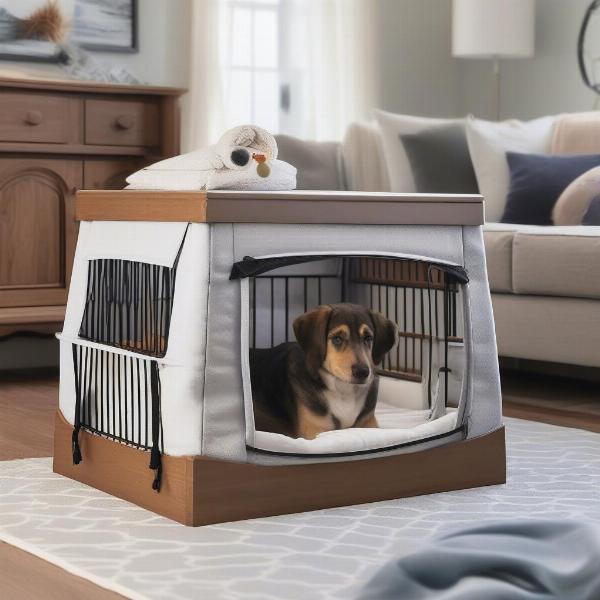Strong dog crates are essential for many dog owners, offering a safe haven, a tool for housetraining, and a secure way to transport your furry friend. Whether you’re a new puppy parent or a seasoned dog owner, choosing the right strong dog crate can be overwhelming. This comprehensive guide will walk you through everything you need to know about selecting, using, and maintaining a strong dog crate for your beloved canine companion.
Choosing the Right Strong Dog Crate
Choosing a strong dog crate depends on several factors, including your dog’s size, breed, temperament, and intended use. Measure your dog carefully to ensure the crate is the right size – large enough for them to stand, turn around, and lie down comfortably, but not so large that they feel encouraged to eliminate in a corner.
Types of Strong Dog Crates
Several types of strong dog crates cater to different needs:
- Heavy-duty metal crates: These are the strongest and most durable option, ideal for dogs who are escape artists or strong chewers. They offer excellent security and ventilation.
- Plastic crates: Lighter and more portable than metal crates, plastic options are suitable for calmer dogs and travel.
- Soft-sided crates: These lightweight, foldable crates are great for travel and portability but are not as secure as metal or hard plastic options and are not suitable for dogs who chew.
- Wooden dog crates: Often chosen for their aesthetic appeal, wooden crates can blend in with your home decor. However, they are not as durable as metal and may not be suitable for all dogs.
Material and Construction
Look for crates constructed from durable materials that can withstand your dog’s strength and chewing habits. For metal crates, thick-gauge steel is a good choice. Welded wire should be sturdy and free of sharp edges. Check for secure latches and locking mechanisms to prevent escapes.
Setting Up Your Dog’s Crate
Creating a comfortable and inviting den is crucial for your dog’s acceptance of the crate.
Bedding and Comfort
Provide soft, comfortable bedding that is washable and durable. A familiar blanket or toy can also help your dog feel more secure in their new space.
Location, Location, Location
Place the crate in a central location in your home where your dog can be a part of the family activities. Avoid placing it in isolated areas or drafty spots.
 Setting up a Dog Crate
Setting up a Dog Crate
Crate Training Your Dog
Introduce your dog to the crate gradually and positively. Never force your dog into the crate. Start by associating the crate with positive experiences, such as feeding them meals inside or offering treats. Gradually increase the amount of time your dog spends in the crate. strong crates for dogs can be especially beneficial during this training period.
Dealing with Crate Anxiety
Some dogs may experience anxiety when first introduced to a crate. Patience and positive reinforcement are key. Never use the crate as punishment. Provide reassurance and comfort, and consider using calming aids such as pheromone diffusers. A dog crate floor grid can help keep the crate clean and comfortable.
Maintaining Your Strong Dog Crate
Regular cleaning is essential to maintain hygiene and prevent odors. Remove bedding and wash it frequently. Clean the crate with a pet-safe disinfectant.
Conclusion
A strong dog crate can be a valuable tool for both dog owners and their furry companions. By choosing the right crate, setting it up properly, and implementing positive crate training techniques, you can provide your dog with a safe, secure, and comfortable den. Remember to prioritize your dog’s well-being and consult with a veterinarian or professional dog trainer if you have any concerns or encounter challenges during the process. A sturdy and reliable crate, like the ones featured on atopease for dogs, can make a world of difference for both you and your pet.
FAQ
- How do I choose the right size crate for my dog? Measure your dog from nose to tail and from the top of their head to the ground. The crate should be large enough for them to stand, turn around, and lie down comfortably.
- What type of crate is best for a strong chewer? Heavy-duty metal crates are the most durable option for strong chewers.
- How do I clean my dog’s crate? Remove bedding and wash it frequently. Clean the crate with a pet-safe disinfectant.
- Can I use a crate for housetraining? Yes, crates can be a helpful tool for housetraining, as dogs naturally avoid soiling their den.
- What should I do if my dog experiences crate anxiety? Patience and positive reinforcement are key. Never use the crate as punishment. Provide reassurance and comfort, and consider using calming aids such as pheromone diffusers. You might also consider stylish and functional modern dog crates.
- Are there specific crates for traveling in vehicles? Yes, you can find crates specifically designed for car travel, and even custom truck dog boxes for larger vehicles.
- What is the best bedding for a dog crate? Choose soft, comfortable bedding that is washable and durable.
ILM Dog is a leading international website dedicated to providing dog owners with expert advice and resources on all aspects of dog care, from breed selection and health to training and nutrition. We offer comprehensive guides, product reviews, and expert insights to help you provide the best possible care for your canine companion. Our team of experienced writers and dog enthusiasts are passionate about sharing their knowledge and helping you build a strong bond with your furry friend. Contact us today for all your dog-related needs: Email: [email protected], Phone: +44 20-3965-8624. Visit ILM Dog for more information.